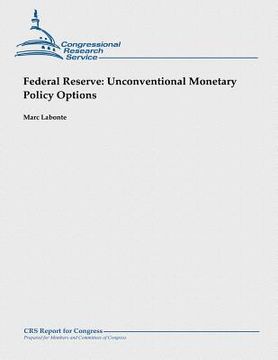Synopsis "Federal Reserve: Unconventional Monetary Policy Options (in English)"
The "Great Recession" and the ensuing weak recovery have led the Federal Reserve (Fed) to reevaluate its monetary policy strategy. Since December 2008, overnight interest rates have been near zero; at this "zero bound," they cannot be lowered further to stimulate the economy. As a result, the Fed has taken unprecedented policy steps to try to fulfill its statutory mandate of maximum employment and price stability. Congress has oversight responsibilities for ensuring that the Fed's actions are consistent with its mandate. The Fed has made large-scale asset purchases, popularly referred to as "quantitative easing" ("QE"), that have increased its balance sheet from $0.9 trillion in 2007 to $2.9 trillion at the end of 2012. Currently, the Fed is purchasing $40 billion of mortgage-backed securities (MBS) and $45 billion of Treasury securities each month; because these purchases follow on two previous rounds of purchases, they have been referred to as "quantitative easing three" or "QEIII." Unlike the previous rounds, the Fed has not announced when QEIII will end or its ultimate size. The Fed views QE as stimulating the economy primarily through lower long-term interest rates, which stimulate spending on business investment, residential investment, and consumer durables. Since QE began, Treasury yields and mortgage rates have reached their lowest levels in decades; it is less clear how much QE has affected private-borrowing rates and interest-sensitive spending. Critics fear QE's potentially inflationary effects, via growth in the monetary base. Inflation has remained low to date, but QE is unprecedented in the United States and the Fed's mooted "exit strategy" for unwinding QE is untested, so the Fed's ability to successfully maintain stable prices while unwinding QE cannot be guaranteed. The Fed has also changed its communication policies since rates reached the zero bound. From 2011 to 2012, it announced a specific date for how long it anticipated that the federal funds rate would be at "exceptionally low levels," and over time incrementally extended that horizon by two years. In December 2012, it replaced the time horizon with an unemployment threshold-as long as inflation remained low, the Fed anticipated that the federal funds rate would be exceptionally low for at least as long as the unemployment rate was above 6.5%. The Fed argues that its new communication policies make its federal funds target more stimulative. In this view, if financial actors are confident that short-term rates will be low for an extended period of time, then longterm rates will be driven down today, thereby stimulating interest-sensitive spending. Uncertainty about economic projections hampers the Fed's ability to stick to a preannounced policy path, and any future backtracking could undermine its credibility. If unconventional policy were failing because it has undermined the Fed's credibility, the evidence would be high interest rates, high inflation expectations, or both; to date, neither has occurred. The sluggish rate of economic recovery suggests that monetary policy alone is not powerful enough to return the economy to full employment quickly after a severe downturn and financial crisis. It also raises questions about the optimal approach to monetary policy. When is the best time to return to withdraw unconventional policies, and in what order? Should unconventional policies only be used during serious downturns, or also in periods of sluggish growth? Do unconventional policies have unintended consequences, such as causing asset bubbles or market distortions? If so, are legislative changes needed to curb the Fed's use of QE, or would that undermine the Fed's policy discretion and interfere with conventional policymaking? Or should the Fed try other proposed unconventional policy tools to provide further stimulus when inflation is low and unemployment is high?

